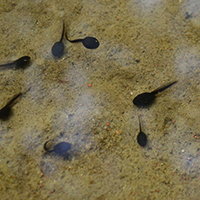Diet of tadpoles for five anuran species of northeast Brazil
Diet of tadpoles to five anuran species

All claims expressed in this article are solely those of the authors and do not necessarily represent those of their affiliated organizations, or those of the publisher, the editors and the reviewers. Any product that may be evaluated in this article or claim that may be made by its manufacturer is not guaranteed or endorsed by the publisher.
Authors
In this study, the diet of tadpoles of five anuran species was described. The species were collected from either lotic or lentic environments in Caatinga and the Atlantic Forest biome of northeast Brazil. The diet of these tadpoles consisted of algae, protozoa, plants, fungi and animals. Diatoms were the most important items within the diet of Leptodactylus natalensis. Trachelomonas, diatoms, Phacus and Scenedesmus were the most important items comprising the diet of Leptodactylus cf. macrosternum. Trachelomonas, Oscillatoria and Scenedesmus were the most important items comprising the diet of Pithecophus nordestinus. Diatoms and Scenodesmus were the most important items of the diet for Rhinella jimi. For Scinax x-signatus, diatoms (Atlantic Forest population), Oscillatoria, undetermined filament and pollen (Caatinga population) were the most important items consumed. Scinax x-signatus and L. natalensis from Atlantic Forest, and L. cf. macrosternum and P. nordestinus from Caatinga had diets that were the most similar. The diversity of items found in the diets of species considered may be attributed to mechanisms used by tadpoles to obtain food, which favour the acquisition of suspended materials that are highly available in the environment. We discuss the possible effects of the relationship between algae and tadpoles and the importance of recording larvae diets to better understand the dynamics of the aquatic environment and the trophic ecology of tadpoles.






